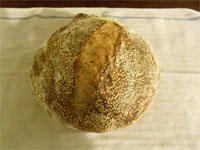What follows is a recipe I adapted from the Tom Cat Semolina Filone recipe in the Glezer book to equate to the common dutch oven standard producing two boules of about 1Kg prebaked weight each. There is only a picture of one boule because the other was sent off to a neighbor while it was still warm.


For those of you not used to a semolina loaf, actually made with durham flour not the coarse semolina, it is remarkable. The result is a loaf that is so sweet that you would guess it was enriched with some sweetener. But it is just flour, water, salt and yeast. It also benefits from the taste of the sesame seeds which encrust it. This bread is terrific with a good olive oil and with rich sauces that cry out to be sopped up.
Here's the recipe:
The poolish prepared night beforeMix 380 gm AP flour with 485 gm water(80-90 degrees F) and 1/8 tsp yeast. Proof overnight at 80F
The next morning
mix 625 gm durham flour, 75 gm AP flour and 445 gm water at 80-90 F. When water is roughly incorporated with flour, let autolyse at ~80F for 30 minutes.
Mix 20 gm salt and 1/4 tsp yeast into bulk dough, add poolish. Mix together by hand until all parts are incorporated. Be careful to incorporate the stiff bulk dough and the soupy poolish well so that there are no hard bits.
Proof the bulk dough until doubled (2.5-3 hrs). During the first hour, do three or four sets of stretch and folds at ~20 minute intervals. This is quite a wet dough so fold it a lot to get it to come together.
Flour the work surface a bit more heavily than you normally would. Divide the dough into two. Rest 15 minutes, shape into boules and roll seam side in sesame seeds. Place seam side down on to rather heavily floured cloths (good time to try rice flour or white rye and place into bannetons. Proof about two hours at 70F. Carefully place into dutch ovens preheated to 450F and immediately turn heat to 400F. Bake covered for 30 minutes and uncovered for 25 more.
This is my favorite Italian bread recipe. Years ago there was a bakery in town that made a bread just like this -- sesame seeds and all. I was sad to see them go under for a lot of reasons, but mainly because I missed this loaf so much. But the Tom Cat Semolina is almost an exact replica, without all the additives. It is my favorite "go to" white Italian bread. The one thing I didn't like about the original was that the recipe makes only one very large loaf, and because this is made with yeast, the shelf life is not so long. Being able to make 2 smaller boules is better. Thanks, Paul, for transforming this.
to sop up some EVOO, Parmesan, cracked pepper and herbs. Yummy! Is this bread baked seam side, sesame seed up? I guess it wouldn't need to be slashed that way and would open up naturally along the seam. Very interesting as well as safer and easier too with hot DO's invovlved!
I was wondering why tou add the last 1/4 tsp of yeast that goes in with the salt and poolish? With such a large and active poolish, is the small amount of additional yeast necessary ? Or, are you worried about the rise without the added yeast?
I might be tempted to ditch the added yeast, hold back the salt with a little bit of water to dissolve it in, let the autolyse and the poolish come together and bench rest for a half hour or so to give the yeast a head start and then add in the held back salt by squishing the dough through the fingers. This would take a half an hour longer, or more, longer and this can make a big difference in your schedule for the day. But who knows.... the flavor of the bread might be better...if that was possible..
Happy baking.
Made the Dutch Oven Semolina Boule Recipe today.
86% hydration was too soupy to work with. Suspect too much water in the poolish. Poolish to my knowledge is 100% hydration. This one is 128% hydrated. After mixing with semolina & remaining flour, total hydration was 86%.
Added 128 grams of flour to lower total hydration to 77%. Bread came out fine. First load wasn’t all that brown. Second loaf was cooked at 460 degrees, covered & uncovered. Nice & brown.